News
A 99-min binary from SDSS-V

In one of the first science results from SDSS-V, collaborators led by Harvard graduate student Vedant Chandra (Chandra et al. 2021) have discovered a double-lined, double-white-dwarf binary orbiting one another every 99 minutes in a paper that was recently accepted for publication by the Astrophysical Journal. The two white dwarfs will merge into a roughly 0.85 solar-mass remnant in less than 300 million years, and the system is already likely giving off enough gravitational waves to be detectable by the LISA mission. A nice Twitter summary of the discovery is here. The pair of stars was found in just the first six months of SDSS-V data, so more exciting discoveries await when the robots take over later this year!
Rotation in shrapnel from a supernova
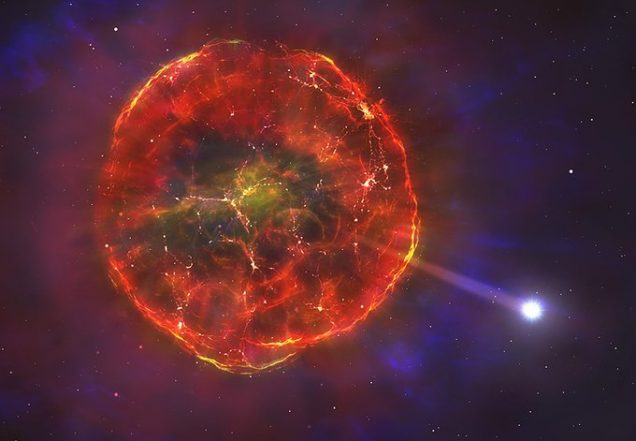
In June 2021 work led by researchers in the BU White Dwarf group discovered that the partly burnt runaway star LP 40-365 (also known as GD 492) rotates every 8.9 hours using archival data from the Transiting Exoplanet Survey Satellite (TESS) and the Hubble Space Telescope (HST) published as Hermes, Putterman, Hollands, et al. 2021. This relatively long rotation period likes adds more evidence that LP 40-365 is actually the bound remnant of an exploded white dwarf itself, the still-simmering embers of a thermonuclear (Type Iax) explosion that slung-shot the star from the Milky Way. An excellent write-up was recently featured in The Brink, and a thread on the discovery of the system is located here: https://twitter.com/jotajotahermes/status/1394298751087435784?s=20. The paper has been published the Astrophysical Journal Letters.
Debris orbiting a white dwarf every 9.9 hours
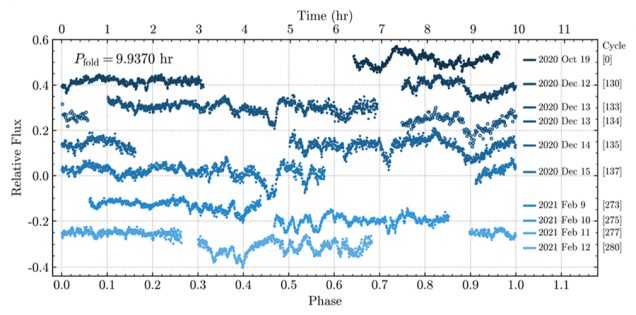
In June 2021, collaborators from all over the world led by UT-Austin graduate student Zach Vanderbosch characterized the orbital period of transiting debris around a new white dwarf: ZTF J0328−1219. The debris shows repeating dips that are stable from night-to-night and repeat every 9.937 hr (shown in the figure above over several nights), as well as some other chunks that repeat every 11.2 hr. Spectra collected by BUWD group members were analyzed to show this is a strongly metal polluted white dwarf; new data show the debris shows circumstellar absorption features from the clouds of debris, as well. The work was accepted for publication and will appear soon in the Astrophysical Journal.
Untangling mysterious emission in some cool white dwarfs
In March 2021 work led by University College London graduate student Nik Walters was accepted to MNRAS analyzing GD 356, the prototype of a new class of just four white dwarfs that exhibit Balmer emission lines despite being apparently isolated stars. Here we provide strong evidence that this emission is not the result of a current generated by a close-in rocky planet; instead, this process may reveal a new phase of white dwarf evolution. This work includes multiple BUWD group researchers, as well as data collected remotely during the COVID-19 pandemic from BU's 1.8-meter Perkins Telescope Observatory, which helped rule out large spin-period changes in this rapidly rotating white dwarf.
More transiting debris found in ZTF
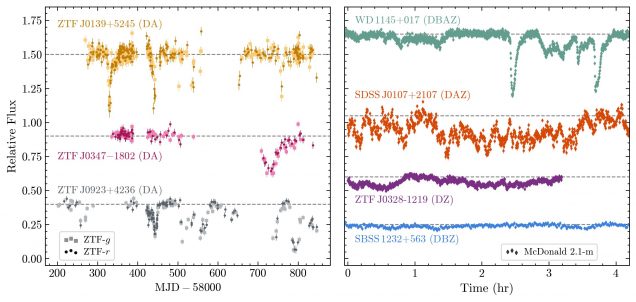
In December 2020 work led by UT-Austin undergraduate student Joseph Guidry and collaborators was posted to arXiv announcing up to five new white dwarfs showing transiting debris from the Zwicky Transient Facility (ZTF), more than tripling the number of such systems known! That work was accepted for publication in March 2021 and will appear soon in ApJ, and includes spectroscopy from the Lowell Discovery Telescope confirming that at least one of the white dwarfs with transiting debris is also heavily polluted by rocky debris. A thread can be found here on Twitter: https://twitter.com/jotajotahermes/status/1334144180231266312?s=20 as well as a thread on how we used Gaia's empirical uncertainties to select variable stars located here: https://twitter.com/jotajotahermes/status/1334509064596893701?s=20
Planetary debris transiting a second white dwarf
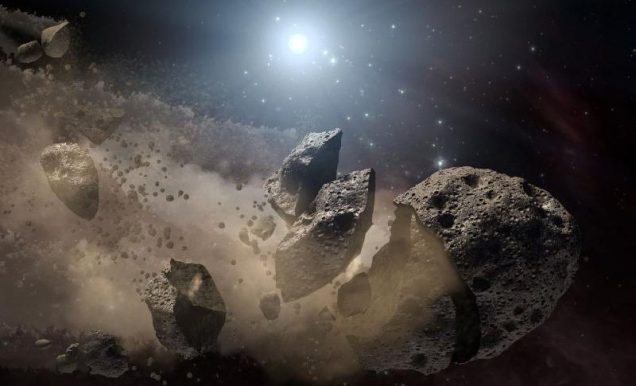
In July 2020, collaborators led by PhD student Zachary Vanderbosch at the University of Texas at Austin have published in The Astrophysical Journal only the second white dwarf known to show transits from an asteroid or planetesimal that got too close to its retired host star. The transits recur roughly every 100 days as the cloud of debris passes in front of the white dwarf. A thread first announcing the submitted paper is here, https://twitter.com/jotajotahermes/status/1166521382336913408, and the system continues to provide interesting surprises, including a deep new transit in November 2020: https://twitter.com/jotajotahermes/status/1326235133297520642
Seeing the interiors of massive A stars with TESS
Collaborators led by Tim Bedding at the University of Sydney published in Nature in May 2020 exciting new results from NASA's TESS mission that are some of the first convincing identifications of the oscillations of a class of massive A stars that pulsate, named after the prototype star delta Scuti. The 2-minute cadence of TESS has finally allowed astronomers to identify the pulsations in delta Scuti stars, especially those that are young. Besides a NASA press release and a Nature News & Views for more general audiences, a thread contextualizing the discovery is here: https://twitter.com/danxhuber/status/1260630021250494470
A puzzling, fast-spinning white dwarf with emission
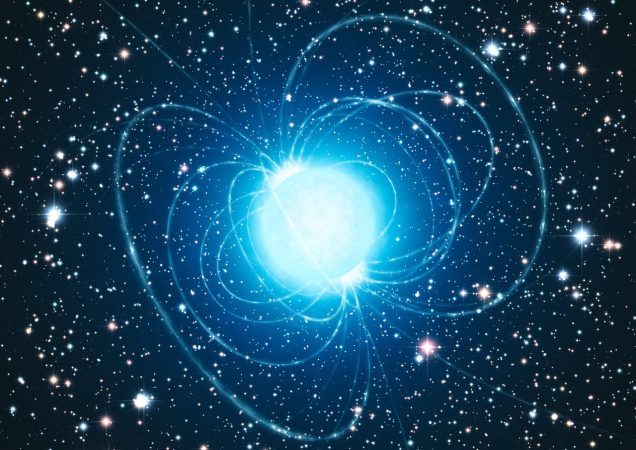
In May 2020, collaborators led by PhD student Josh Reding at the University of North Carolina at Chapel Hill published in The Astrophysical Journal the fastest-rotating, isolated white dwarf. The star spins on its axis every 317 seconds, and is only the second white dwarf to show Balmer emission lines -- the origin of this emission is still puzzling, and could be connected to the induction of a current from a close-in rocky planet. A thread detailing this highly magnetic stellar remnant is here: https://twitter.com/jotajotahermes/status/1242792338751205376
Pulsations & eclipses in a white dwarf
In March 2020, collaborators led by Steven Parsons at the University of Sheffield published in Nature Astronomy the first pulsating white dwarf ever found in a binary system that also exhibits eclipses. Having both pulsations and eclipses in this low-mass (0.325 solar-mass) white dwarf will put some exceptional constraints on the star. We already know the radius of the star to 2% precision, less than 300 km, and know its mass to better than 4% -- this will be an excellent benchmark to understand how stars are stripped of mass at the end of their lives. Aside from a press release with an artist's impression from the University of Sheffield, a thread with more details can be found here: https://twitter.com/jotajotahermes/status/1240259598831026177
An old failed star
Collaborators, led by PhD student ZJ Zhang at the University of Hawaii, have discovered a bound pair of stars that serve as an exciting benchmark: one is a T4 (<1300 K) brown dwarf, the other is a very cool (5100 K) white dwarf. White dwarfs can serve as useful age indicators, and so we used this very cool white dwarf (which we suspect is roughly 7.3 billion years old) to constrain the age of the pair of stars. This old age puts unique constraints on interpreting the brown dwarf -- modeling the atmosphere of these failed stars is very complicated! A thread with more information from is located on Twitter: https://twitter.com/astrozjzhang/status/1229514446118121472